Background
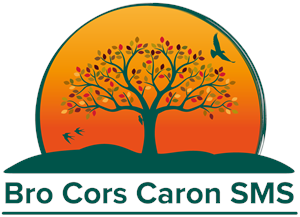 The Bro Cors Caron SMS consists of a group of eight farmers bordering the northern end of the Cors Caron National Nature Reserve. Adopting the GWCT’s ‘Farmer Cluster’ approach, conservation practices will be carried across the eight farms, magnifying the associated benefits across the landscape to improve the health of the catchment for Cors Caron.
The Bro Cors Caron SMS consists of a group of eight farmers bordering the northern end of the Cors Caron National Nature Reserve. Adopting the GWCT’s ‘Farmer Cluster’ approach, conservation practices will be carried across the eight farms, magnifying the associated benefits across the landscape to improve the health of the catchment for Cors Caron.
The project will be led by the GWCT (which submitted a successful application to Welsh Government for SMS funding), but ultimately the decisions will be made by the eight farmers, who have set up a Community Interest Company (CIC). A small steering group will be consulted and pass any decisions that are to be made, ensuring that the objectives of the project are met. There will also be an advisory group for the project, which will include individuals from a variety of local and national organisations. The advisory group will provide advice, support and resources as and where they can, allowing the farmers in the project to achieve their desired goals.
Facts and figures
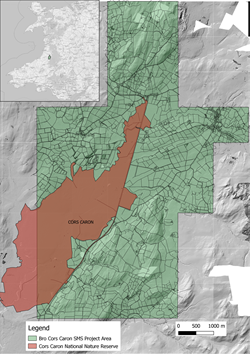 The scheme is funded by the Welsh Government and the European Union.
The scheme is funded by the Welsh Government and the European Union.- Cors Caron NNR, which the project area borders, covers approximately 800 hectares and is one of the largest actively growing raised bogs in lowland Britain.
- The Bro Cors Caron SMS project covers approximately 1,900 hectares.
- This is a two-year project, which started in June 2021 and ends in June 2023.
- In addition to the eight farmers, the project team also includes one Wildlife Warden, one Project Manager, one Project Accountant and two Project Facilitators.
- The steering group consists of four individuals, while the advisory group is open to numerous organisations. It currently includes representatives from the following:
- Government bodies (Natural Resources Wales)
- Farmers’ unions (Farmers’ Union of Wales, National Farmers’ Union)
- Advisory services (Farming Connect, Farming and Wildlife Advisory Group)
- Researchers (Institute of Biological, Environmental & Rural Sciences, Aberystwyth University)
- Conservation groups (Ceredigion Local Nature Partnership)
What are the objectives of the project?
To demonstrate to Welsh Government’s new Sustainable Farming Scheme that farmer-led schemes promoting economically viable farmed landscapes and increased biodiversity is completely possible and cost effective.
In order to reach this ambition of building an improved environment alongside a resilient agri-business, we aim to:
- Reverse local biodiversity declines
- Improve water quality on the farms
- Improve the health of the soil on the farms
- Farm productively and profitably
- Engage with the local community
How will these objectives be achieved?
Objectives 1, 2 and 3
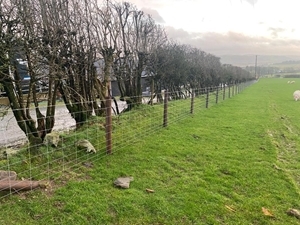 By following a farmer-led approach to landscape-scale management, we aim to work with the farmers, experts and the local community in order to link high-quality habitats to create continuous corridors across the catchment, allowing the enhancement of biodiversity and other public goods, such as carbon storage.
By following a farmer-led approach to landscape-scale management, we aim to work with the farmers, experts and the local community in order to link high-quality habitats to create continuous corridors across the catchment, allowing the enhancement of biodiversity and other public goods, such as carbon storage.
The GWCT “three-legged stool” approach is a tried-and-tested conservation methodology used on the Trust’s demonstration farms at the Allerton Project in Leicestershire and at Auchnerran in Aberdeenshire. The principle is that there are three components to restoring farmland biodiversity: habitat development, food provision, and predator control. These three practices should be performed in unison in order to maximise the chances of wildlife successfully returning to farms. A suite of conservation techniques reflecting this ethos will be explored during the project. These include:
- Hedgerow and tree planting: this provides a great habitat for a variety of small farmland birds such as house sparrows and chaffinches. Both have the advantage of sequestering carbon; however hedgerows have the added benefit of connecting habitats and acting as natural land boundaries, without impeding the productivity of the land for farming.
- Buffer and barrier strips: by fencing off hedgerows and water courses, it provides another habitat for wildlife between the field and the natural feature. The long and tussocky grass not only supports insects, small mammals and farmland birds, the strips also reduce nutrients and sediments flowing off the land into the water course.
- In-field wetlands: like the strips, creating ponds and scrapes in fields reduces soil erosion; and nutrient and sediment run-off. The wetland habitat also provides a rich source of invertebrates, which is perfect feeding for some of the most threatened species in Wales such as lapwings.
- Cover crops: these are unharvested crops that can improve soil health by acting as an armour and providing additional nutrients. They also provide a source of food and shelter for small farmland birds and mammals throughout the year: seeds during the winter, and insects during the summer.
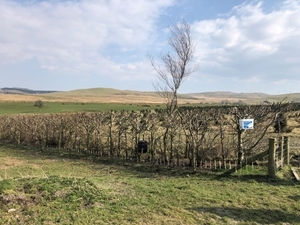 Supplementary feeding: despite the benefits of cover crops, sometimes more is needed to help our declining farmland birds, especially in the ‘hungry gap’ of December to April. Feeding hoppers filled with wild bird seed mixes is a good way to provide food during this period.
Supplementary feeding: despite the benefits of cover crops, sometimes more is needed to help our declining farmland birds, especially in the ‘hungry gap’ of December to April. Feeding hoppers filled with wild bird seed mixes is a good way to provide food during this period.- Predator control: the benefits of predator control (e.g foxes and corvids) in conjunction with providing good quality habitat and food are magnified when done in collaboration with neighbouring landowners, easing the predation pressure experienced by threatened ground-nesting species such as curlews. It is essential that any predator control follows ‘best practice’ methodology, therefore a trained Wildlife Warden will co-ordinate the activity across the whole project area.
An essential part of ensuring that such management practices are successful is to survey the project area. Therefore, each farm was surveyed by an advisor, and has received a management plan detailing potential works that could be carried out and where they would be suitable. In addition to this, various other surveys have allowed for the establishment of a baseline dataset. Future survey and monitoring work during and after the project will allow the impacts that the works are having on the local biodiversity, soil and water to be assessed against this baseline.
Objective 4
Having farmers at the heart of project means that these conservation efforts are set against the background of a food production system. Neither the local biodiversity nor the farmers can afford to be detrimental to one another if they are to successfully coexist; farmers need to make a livelihood from the land also.
Therefore, the training and development of the farmers will be paramount to the success project. The training will encompass many disciplines, ranging from land and wildlife management skills (e.g. best practice predator control), to modern sustainable farming practices (e.g. rotational grazing). This will be delivered via training courses, seminars, workshops and visits to other project sites and farms.
Objective 5
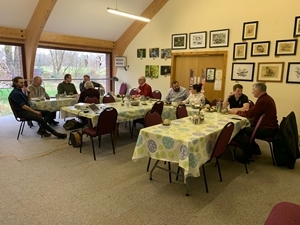 The well-being of the nation is an essential part of all projects following Wales’ introduction of the Well-Being Future Generation Act Wales in 2015. Public engagement means reaching out to a wider audience involving the local community to help them understand the project and its aims. By encouraging their involvement, it will not only ascertain the goals beyond the direct project participants, but also improve their well-being (the health advantages for people from exposure to nature and wildlife are well documented).
The well-being of the nation is an essential part of all projects following Wales’ introduction of the Well-Being Future Generation Act Wales in 2015. Public engagement means reaching out to a wider audience involving the local community to help them understand the project and its aims. By encouraging their involvement, it will not only ascertain the goals beyond the direct project participants, but also improve their well-being (the health advantages for people from exposure to nature and wildlife are well documented).
We therefore intend on engaging with the local community throughout the project. This will involve visits by students from Ysgol Pontrhydfendigaid and Ysgol Henry Richard in Tregaron, where they will be able to participate in various activities such as citizen science tasks and nest box erection. There will also be the opportunity for outreach work with other local organisations, such as wildlife groups (e.g. British Trust for Ornithology), farming groups (e.g. Ceredigion Young Farmers Club) and history groups (e.g The Strata Florida Group) by organising events and presentations.
“Combining the efforts of everyone can magnify the advantages of (the work of) individuals, leading to greater gains at a landscape scale.”